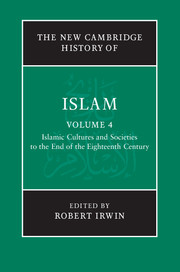Book contents
- Frontmatter
- Introduction
- PART I RELIGION AND LAW
- PART II SOCIETIES, POLITICS AND ECONOMICS
- PART III LITERATURE
- 13 Arabic literature
- 14 Persian literature
- 15 Turkish literature
- 16 Urdu literature
- 17 History writing
- 18 Biographical literature
- 19 Muslim accounts of the dār al-ḥarb
- PART IV LEARNING, ARTS AND CULTURE
- Glossary
- Bibliography
- Index
- References
18 - Biographical literature
from PART III - LITERATURE
Published online by Cambridge University Press: 28 March 2011
- Frontmatter
- Introduction
- PART I RELIGION AND LAW
- PART II SOCIETIES, POLITICS AND ECONOMICS
- PART III LITERATURE
- 13 Arabic literature
- 14 Persian literature
- 15 Turkish literature
- 16 Urdu literature
- 17 History writing
- 18 Biographical literature
- 19 Muslim accounts of the dār al-ḥarb
- PART IV LEARNING, ARTS AND CULTURE
- Glossary
- Bibliography
- Index
- References
Summary
Terms and definitions
Much of the so-called biographical literature in classical Arabic, Persian and Turkic has little in common with modern biography. Most of the pre-modern examples consist of short entries collected together in so-called biographical dictionaries. To modern readers such entries seem oddly uninformative. An entry on a poet, for example, may contain extensive citations of his or her verses, but practically nothing about his life. An entry on a jurist, similarly, will list his teachers and students, his works and his date of death; but it will not report his reasons for embarking upon the study of the law, or attempt to account for his professional successes and failures by referring to his quirks of personality. Because of these differences, some modern scholars refer to entries in collective works as ‘prosopography’, reserving the term ‘biography’ only for stand-alone works devoted to a single subject. Yet even the biographies proper display little interest in how the subject ‘came to be who he was’. His character is tacitly assumed to be fixed, and the succession of anecdotes merely displays it from different points of view.
- Type
- Chapter
- Information
- The New Cambridge History of Islam , pp. 458 - 473Publisher: Cambridge University PressPrint publication year: 2010

